
Don't you remember the days when video games were fun and not all about graphics? I do and I miss those days of the SNES and the Gameboy Color. Now let's go back to my childhood.
Let's begin with a look at a couple of game systems.
Super Nintendo
The Super Nintendo Entertainment System or Super NES (also called SNES and Super Nintendo) is a 16-bit video game console that was released by Nintendo in 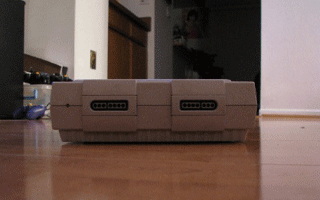 North America, Europe, Australia, Central America, South America and Brazil between 1990 and 1993. In Japan and Southeast Asia, the system is called the Super Family Computer, Super Famicom. In South Korea, it is known as the Super Comboy and was distributed by Hyundai Electronics. Although each version is essentially the same, several forms of regional lockout prevent direct compatibility.The Super Nintendo Entertainment System was Nintendo's second home console, following the Nintendo Entertainment System (NES). The console introduced advanced graphics and sound capabilities that compensated for its relatively slow CPU, compared with other consoles at the time. Additionally, the system's support for numerous enhancement chips (which shipped as part of certain game cartridges) helped to keep it competitive in the marketplace. SNES was a global success, becoming the best-selling console of the 16-bit era despite its relatively late start and the fierce competition it faced in North America from Sega's Genesis console. The SNES remained popular well into the 32-bit era, and although Nintendo has dropped all support for the console, it continues to be popular among fans and collectors
North America, Europe, Australia, Central America, South America and Brazil between 1990 and 1993. In Japan and Southeast Asia, the system is called the Super Family Computer, Super Famicom. In South Korea, it is known as the Super Comboy and was distributed by Hyundai Electronics. Although each version is essentially the same, several forms of regional lockout prevent direct compatibility.The Super Nintendo Entertainment System was Nintendo's second home console, following the Nintendo Entertainment System (NES). The console introduced advanced graphics and sound capabilities that compensated for its relatively slow CPU, compared with other consoles at the time. Additionally, the system's support for numerous enhancement chips (which shipped as part of certain game cartridges) helped to keep it competitive in the marketplace. SNES was a global success, becoming the best-selling console of the 16-bit era despite its relatively late start and the fierce competition it faced in North America from Sega's Genesis console. The SNES remained popular well into the 32-bit era, and although Nintendo has dropped all support for the console, it continues to be popular among fans and collectors
Comments: I originally grew up with the Super Nintendo. It was literally my first video game system. In fact, I started playing the system at the age of four years old. Although my parents didn't allow me to play and it was my brother's system, I was able to sneak playing video game while my parents were at work and my brother at school. I still own the game system to this very. It's currently sitting next to my other older game systems.
Gameboy
The Gameboy series is a handheld system developed by Nintendo. It began with the original Gameboy in 1989 and continue with the Gameboy Pocket, Ga meboy Color, Gameboy Advance, and the Gameboy Micro. The handheld uses a cartridge system, where all the game data is stored in a plastic game cartridge. The Gameboys are powered by triple and/or double A battery.
meboy Color, Gameboy Advance, and the Gameboy Micro. The handheld uses a cartridge system, where all the game data is stored in a plastic game cartridge. The Gameboys are powered by triple and/or double A battery.
Comments: The Gameboy is the first handheld that I played. Although I did own the Super Nintendo by the time I receive the Gameboy, it did entertain me on the long car rides and while my parents went shopping.
Super Mario World
Super Mari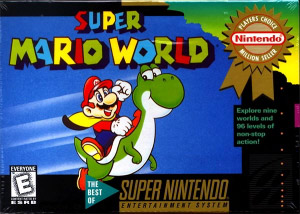 o World is a platform game developed and published by Nintendo Co., Ltd. as a pack-in launch title for the Super Famicom/Super Nintendo Entertainment System. It has gone on to become a tremendous critical and commercial success, becoming the best seller for the platform, with 20 million copies sold worldwide. Like in previous games in the Mario series, the plot involves Mario traversing through different lands on a quest to rescue Princess Toadstool, who has been kidnapped by Bowser. This is a side-stroller as in previous Mario games, and it takes advantage of the Super Nintendo's 16-bit graphics and stereo sound. The game consists of a journey through levels in seven worlds: Yoshi's Island, Donut Plains, Vanilla Dome, and Twin Bridges Area terminating in Cookie Mountain, Forest of Illusion, Chocolate Island, and the Valley of Bowser. There are also two secret worlds - Star Road and Special Zone which can be found by finding a key and a key hole in certain levels. Experienced players can utilize the Star Road to reach the end of the game in only 12 levels. Super Mario World contains a "world map" screen, which provides a passive overview of all the game's levels; each level is accessed individually from the world map. The concept was previously seen in Super Mario Bros. 3, and World's execution is similar but more elaborate. The game features 72 courses laid out across the seven worlds, and 96 exits (some levels have more than one exit; these levels are usually marked red). Secret exits open up new routes on the over world map, often leading to secret levels. When a player reaches the completion of the 96 "goals," the beginning screen will display a star next to the number "96" beside the file the goals were completed on. Something to consider, however, is the fact that the game cover states that it contains "96 levels," implying that the number of stages and exits are equal when in reality there are only 72 true levels.
o World is a platform game developed and published by Nintendo Co., Ltd. as a pack-in launch title for the Super Famicom/Super Nintendo Entertainment System. It has gone on to become a tremendous critical and commercial success, becoming the best seller for the platform, with 20 million copies sold worldwide. Like in previous games in the Mario series, the plot involves Mario traversing through different lands on a quest to rescue Princess Toadstool, who has been kidnapped by Bowser. This is a side-stroller as in previous Mario games, and it takes advantage of the Super Nintendo's 16-bit graphics and stereo sound. The game consists of a journey through levels in seven worlds: Yoshi's Island, Donut Plains, Vanilla Dome, and Twin Bridges Area terminating in Cookie Mountain, Forest of Illusion, Chocolate Island, and the Valley of Bowser. There are also two secret worlds - Star Road and Special Zone which can be found by finding a key and a key hole in certain levels. Experienced players can utilize the Star Road to reach the end of the game in only 12 levels. Super Mario World contains a "world map" screen, which provides a passive overview of all the game's levels; each level is accessed individually from the world map. The concept was previously seen in Super Mario Bros. 3, and World's execution is similar but more elaborate. The game features 72 courses laid out across the seven worlds, and 96 exits (some levels have more than one exit; these levels are usually marked red). Secret exits open up new routes on the over world map, often leading to secret levels. When a player reaches the completion of the 96 "goals," the beginning screen will display a star next to the number "96" beside the file the goals were completed on. Something to consider, however, is the fact that the game cover states that it contains "96 levels," implying that the number of stages and exits are equal when in reality there are only 72 true levels.
Mario is capable of a variety of new moves, including a "spin jump". Mario can pick up and throw items, but is now also able to throw them up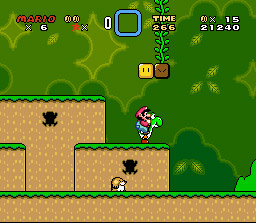 wards or set them down gently. In addition to the classic Fire Flower ability to project fireballs, the Cape Feather allows Mario to fly with a cape. He can also use the cape to glide down slowly and thus traverse wide distances while airborne. Conveniently, Mario can receive cape and fire power-ups even when he is regular Mario, eliminating the need to "power-up" to Super Mario first. Mario can also spin jump in this game allowing him to ricochet off of hazardous surfaces, break through blocks (only when "Super"), and destroy enemies he would normally bounce off of; a cape spin jump will cause the cape to hit enemies adjacent to Mario, while a fire spin jump will launch one fireball each to Mario's left and right. Mario can also look straight up, although this ability is not useful in-game, other than controlling "direction coins," coins that move up, down, etc., from blocks. Finally, Super Mario World introduced Yoshi, a dinosaur Mario can ride. The Yoshis appear in four different colors (green, yellow, red, and blue), each with different abilities. Upon eating a shell of any color, blue Yoshis can fly, red Yoshis can spit fire, and yellow Yoshis stomp the ground, hurting nearby enemies. A yellow shell that has been entered by a Koopa becomes multicolored, allowing Yoshis of any color to fly, stomp, and spit fire all in one. There are also Baby Yoshis in the Star World levels which can be picked up by Mario. After eating five enemies, three berries, or any power-up, they will become a fully grown Yoshi of the same color.
wards or set them down gently. In addition to the classic Fire Flower ability to project fireballs, the Cape Feather allows Mario to fly with a cape. He can also use the cape to glide down slowly and thus traverse wide distances while airborne. Conveniently, Mario can receive cape and fire power-ups even when he is regular Mario, eliminating the need to "power-up" to Super Mario first. Mario can also spin jump in this game allowing him to ricochet off of hazardous surfaces, break through blocks (only when "Super"), and destroy enemies he would normally bounce off of; a cape spin jump will cause the cape to hit enemies adjacent to Mario, while a fire spin jump will launch one fireball each to Mario's left and right. Mario can also look straight up, although this ability is not useful in-game, other than controlling "direction coins," coins that move up, down, etc., from blocks. Finally, Super Mario World introduced Yoshi, a dinosaur Mario can ride. The Yoshis appear in four different colors (green, yellow, red, and blue), each with different abilities. Upon eating a shell of any color, blue Yoshis can fly, red Yoshis can spit fire, and yellow Yoshis stomp the ground, hurting nearby enemies. A yellow shell that has been entered by a Koopa becomes multicolored, allowing Yoshis of any color to fly, stomp, and spit fire all in one. There are also Baby Yoshis in the Star World levels which can be picked up by Mario. After eating five enemies, three berries, or any power-up, they will become a fully grown Yoshi of the same color.
Super Mario World was the first Mario game to provide the option of exiting a level without losing a life or completing it. This capability is only activated after the player has finished the level at least once. When replaying a level, players can exit to the map screen by pressing the START button to pause the game, then pressing SELECT. It was also the first Mario game to use a visible halfway point marker in levels; if the player is able to activate the marker, and dies or exits the level before reaching the end, they will arrive at the marker's location when re-entering the level. The marker will stay "set" even if the player does not immediately re-enter the level, and will not be reset until that level is completed. The marker will even turn Regular Mario into Super Mario.
Comments: This was the first video game that I played. Boy was it fun... I remember sneaking into my brother's room while he was at school just to play the game. I usually spent more than three hours just to play this game. Good thing my brother eventually gave me the game system for a computer so I got to play this game even more.
Super Mario RPG
Super Mario RPG: Legend of the Seven Star is a hybrid adventure/console role-playing game developed and published by Square and Nintendo. Nintendo first released the game on March 9, 1996 in Japan and on May 13, 1996 in North America. Neither Nintendo nor Squaresoft ever released a PAL version.
Super Mario RPG is the final Mario game for the Super Nintendo Entertainment System video game console, as well as being one of the last games Squar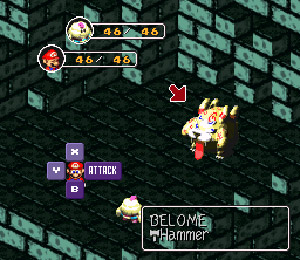 e produced for Nintendo hardware until Chocobo Land: A Game of Dice in 2002. The game was mainly developed by Square with direct guidance from producer Shigeru Miyamoto. IGN confirmed that Nintendo will re-release Super Mario RPG: Legend of the Seven Stars on Wii's Virtual Console in North America in 2007.
e produced for Nintendo hardware until Chocobo Land: A Game of Dice in 2002. The game was mainly developed by Square with direct guidance from producer Shigeru Miyamoto. IGN confirmed that Nintendo will re-release Super Mario RPG: Legend of the Seven Stars on Wii's Virtual Console in North America in 2007.
Super Mario RPG is the first game in which Mario and Bowser fight as allies, and the first console role-playing game (RPG) in the Mario series. Mario's enemies are visible in the field; a battle ensues only if he comes in contact with one. This allows the player to evade unnecessary battles. It should be noted that some fights are necessary to advance the plot. Avoiding battles also means acquiring fewer experience points, causing characters to take greater, and inflict less, damage from attacks, making battles more difficult.
The story begins with Mario entering Bowser's Castle to rescue Princess Toadstool. Mario defeats Bowser, but a giant earthquake caused by a sword named Exor shakes the castle, sending Mario, Bowser, and Princess Toadstool flying in three different directions.
Comments: Super Mario RPG was my absolute favorite game in my childhood. I always played this game after I bought it. This is one of the few games that I would play for hours and hours and replay over and over.
Pokémon
The original Pokémon games were Japanese RPG's with an element of strategy, and were created by Satoshi Tajiri for the Game Boy. These role-playing games, and their sequels, remakes, and English language translations, are still considered the "main" Pokémon games, and the games which most fans of the series are familiar with.
All of the licensed Pokémon properties overseen by The Pokémon Company are divided roughly by generation. These 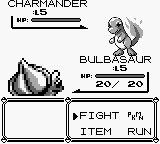 generations are roughly chronological divisions by release; every several years, when an official sequel in the main RPG series is released that features new Pokémon, characters, and gameplay concepts, that sequel is considered the start of a new generation of the franchise. The main games and their spin-offs, the anime, the manga, and the trading card game are all updated with the new Pokémon properties each time a new generation begins. The franchise is currently in its fourth generation.The Pokémon franchise started off in its first generation with its initial release of Pocket Monsters Aka and Midori for the Game Boy in Japan. When these games proved extremely popular, an enhanced Ao version was released sometime after, and the Ao version was reprogrammed as Pokémon Red and Blue for international release. The games launched in the United States on September 30, 1998. The original Red and Green versions were never released outside of Japan. Afterwards, a further enhanced remake titled Pokémon Yellow was released to partially take advantage of the color palette of the Game Boy Color, as well as to feature more of a stylistic resemblance to the popular Pokémon anime. This first generation of games introduced the original 151 species of Pokémon (in National Pokédex order, encompassing all Pokémon from Bulbasaur to Mew), as well as the basic game concepts of capturing, training, battling, and trading Pokémon with both computer and human players. These versions of the games take place within the fictional Kanto region, though the name "Kanto" was not used until the second generation.
generations are roughly chronological divisions by release; every several years, when an official sequel in the main RPG series is released that features new Pokémon, characters, and gameplay concepts, that sequel is considered the start of a new generation of the franchise. The main games and their spin-offs, the anime, the manga, and the trading card game are all updated with the new Pokémon properties each time a new generation begins. The franchise is currently in its fourth generation.The Pokémon franchise started off in its first generation with its initial release of Pocket Monsters Aka and Midori for the Game Boy in Japan. When these games proved extremely popular, an enhanced Ao version was released sometime after, and the Ao version was reprogrammed as Pokémon Red and Blue for international release. The games launched in the United States on September 30, 1998. The original Red and Green versions were never released outside of Japan. Afterwards, a further enhanced remake titled Pokémon Yellow was released to partially take advantage of the color palette of the Game Boy Color, as well as to feature more of a stylistic resemblance to the popular Pokémon anime. This first generation of games introduced the original 151 species of Pokémon (in National Pokédex order, encompassing all Pokémon from Bulbasaur to Mew), as well as the basic game concepts of capturing, training, battling, and trading Pokémon with both computer and human players. These versions of the games take place within the fictional Kanto region, though the name "Kanto" was not used until the second generation.
Comments: The overrated Pokémon series... This is one of the very few games that I would play to this very day. Although the graphics are not as great as the newer games in the series, the games were still very fun. I remember trying to collect all 151 Pokémon, catching the same Pokémon multiple times, training my top six favorite, challenging the Elite Four countless times, and trading off Pokémon to friends. Although I stop playing Pokémon after the Gold and Silver series, the old series still has that pure childhood fun that a child today would receive playing the Diamond and Pearl series.
Sources:
Super Mario World, Jimmy Wales, Wikipedia, http://en.wikipedia.org/wiki/Super_Mario_World
Super Mario RPG, Jimmy Wales, Wikipedia, http://en.wikipedia.org/wiki/Super_mario_rpg
Pokémon video game series, Jimmy Wales, Wikipedia, http://en.wikipedia.org/wiki/Pok%C3%A9mon_video_game_series
Super Nintendo Entertainment System, Jimmy Wales, Wikipedia, http://en.wikipedia.org/wiki/Super_Nintendo